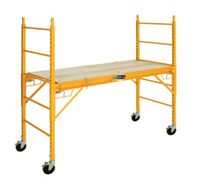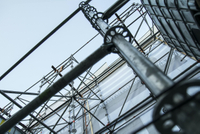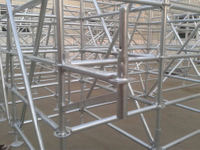Content Menu
● What Is a Scaffolding Frame System?
● Key Components of a Scaffolding Frame System
● Why Use a Scaffolding Frame System?
● Types of Projects That Require a Scaffolding Frame System
>> 1. Residential Construction
>> 2. Commercial Construction
>> 3. Industrial Projects
>> 4. Infrastructure and Civil Engineering
>> 5. Renovation and Restoration
>> 6. Event and Stage Construction
>> 7. Specialized and Complex Projects
● Expanding Applications: Modern Trends and Innovations
>> Digital Planning and BIM Integration
>> Sustainability and Lifecycle Management
>> Safety Innovations
● Scaffolding Frame System vs. Other Scaffolding Types
● Best Practices for Using a Scaffolding Frame System
● Maintenance and Inspection for Long-Term Safety
● Training and Certification
● Conclusion
● FAQ
>> 1. What are the main components of a scaffolding frame system?
>> 2. Which projects benefit most from a scaffolding frame system?
>> 3. How does a scaffolding frame system enhance safety?
>> 4. Can a scaffolding frame system be used indoors and outdoors?
>> 5. What are the best practices for maintaining a scaffolding frame system?
The scaffolding frame system is a cornerstone of safe, efficient, and versatile access in the construction, maintenance, and industrial sectors. Whether you're building a new home, renovating a high-rise, or maintaining a chemical plant, understanding which projects require a scaffolding frame system and why is essential for project managers, contractors, and safety professionals. This article explores the wide range of applications for scaffolding frame systems, their benefits, best practices, and answers to common questions.
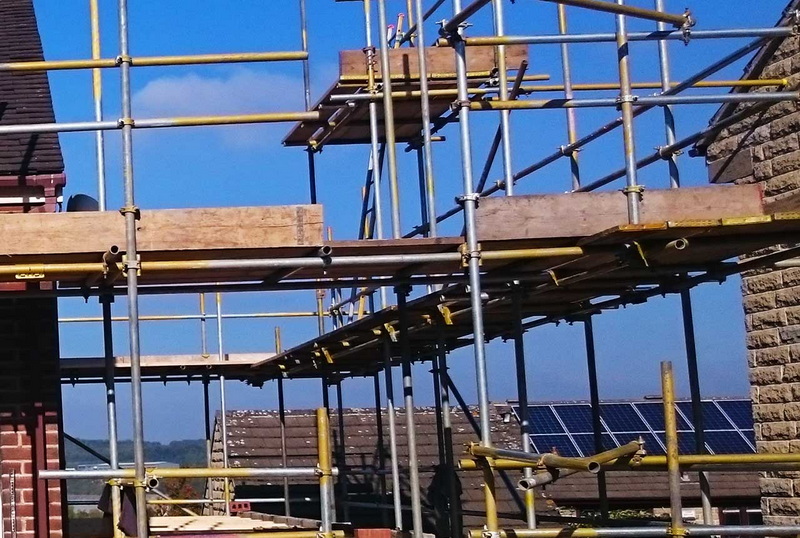
What Is a Scaffolding Frame System?
A scaffolding frame system is a modular, prefabricated structure composed of vertical frames, cross braces, platforms, base plates, and safety accessories. These systems are designed to create stable and elevated work platforms, enabling workers to perform tasks at height safely and efficiently. Frame systems are known for their simplicity, speed of assembly, and adaptability to various project needs.
Key Components of a Scaffolding Frame System
- Frames: The main vertical elements, available in various heights and widths.
- Cross Braces: Diagonal or horizontal connectors that provide structural stability.
- Base Plates/Adjustable Jacks: Distribute load and ensure level footing.
- Platforms/Planks: Create the working surface for laborers.
- Guardrails and Toeboards: Prevent falls and dropped objects.
- Couplers, Clamps, and Accessories: Securely connect and reinforce the system.
Why Use a Scaffolding Frame System?
- Safety: Provides a stable, OSHA-compliant work platform with integrated fall protection.
- Versatility: Adaptable to a wide range of project types and site conditions.
- Efficiency: Modular design allows for rapid assembly, adjustment, and dismantling.
- Cost-Effectiveness: Reusable components and quick setup reduce labor and material costs.
- Load-Bearing Capacity: Designed to support heavy workers, tools, and materials.
Types of Projects That Require a Scaffolding Frame System
1. Residential Construction
Frame scaffolding is widely used in residential projects for:
- New Home Builds: Exterior wall access for masonry, siding, and roofing.
- Renovations: Painting, window replacement, and facade repairs.
- Additions: Safe access for building extensions or second stories.
2. Commercial Construction
Commercial buildings often require extensive scaffolding for:
- Office Towers and Retail Centers: Exterior cladding, glazing, and facade installation.
- Schools, Hospitals, and Public Buildings: Safe access for large-scale renovations or new construction.
- Masonry and Concrete Work: Supporting bricklayers and concrete formwork at height.
3. Industrial Projects
Industrial settings demand robust, adaptable scaffolding for:
- Plant Maintenance: Safe access for repairs, inspections, and upgrades in factories and refineries.
- Shutdowns and Turnarounds: Rapid assembly and disassembly during scheduled maintenance periods.
- Equipment Installation: Supporting heavy tools and machinery at height.
4. Infrastructure and Civil Engineering
Infrastructure projects often require scaffolding frame systems for:
- Bridges and Overpasses: Access for construction, repair, and painting.
- Tunnels and Subways: Interior work on walls and ceilings.
- Water Towers and Silos: Exterior maintenance and upgrades.
5. Renovation and Restoration
Frame scaffolding is essential for:
- Historic Building Restoration: Careful access to delicate facades and architectural details.
- Facade Cleaning and Repairs: Safe, stable platforms for workers and equipment.
- Interior Renovations: Temporary platforms for ceiling, lighting, and HVAC work.
6. Event and Stage Construction
Beyond traditional construction, scaffolding frame systems are used for:
- Concert Stages and Viewing Platforms: Quick assembly and safe support for large crowds.
- Temporary Structures: Platforms for lighting, sound, and camera crews.
- Grandstands and Bleachers: Modular seating for sporting and entertainment events.
7. Specialized and Complex Projects
Frame scaffolding is also used in:
- Shipbuilding and Marine Maintenance: Access for hull repairs and painting.
- Mining Operations: Platforms for shaft work and equipment installation.
- Power Plants: Maintenance and upgrades in high-risk environments.
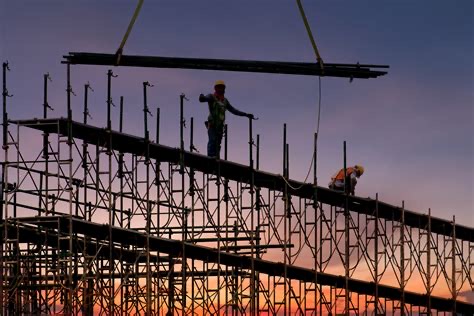
Expanding Applications: Modern Trends and Innovations
Digital Planning and BIM Integration
The use of Building Information Modeling (BIM) and digital planning tools is revolutionizing how scaffolding frame systems are designed and managed:
- 3D Visualization: Planners can model scaffolding layouts in relation to the building, optimizing material use and safety.
- Clash Detection: Digital tools help prevent conflicts with other trades and building elements.
- Documentation: Digital records streamline inspections, maintenance, and compliance.
Sustainability and Lifecycle Management
Modern scaffolding frame systems are designed for sustainability and reusability:
- Durable Materials: Galvanized steel and powder-coated finishes extend service life.
- Component Reuse: Modular parts can be redeployed across multiple projects, reducing waste.
- Efficient Logistics: Stackable frames and platforms optimize transport and storage.
Safety Innovations
- Advanced Guardrail Systems: Improved fall protection and easier installation.
- Integrated Access Ladders: Built-in ladders for safer vertical movement.
- Smart Tagging: RFID or barcode tracking for inventory and inspection management.
Scaffolding Frame System vs. Other Scaffolding Types
| Feature | Scaffolding Frame System | System Scaffolding (Ringlock/Cuplock) | Suspended Scaffolding | Mobile Scaffolding |
| Assembly Speed | Fast | Moderate | Fast | Fast |
| Adaptability | Moderate | High | Limited | High |
| Load Capacity | High | Very High | Moderate | Moderate |
| Best For | Rectangular/Regular | Complex/Irregular/Heavy-Duty | High-Rise Facades | Indoor/Short-Term |
| Cost | Low-Moderate | Moderate-High | Moderate | Moderate |
Best Practices for Using a Scaffolding Frame System
- Follow Manufacturer Guidelines: Always assemble and use components as specified.
- Conduct Regular Inspections: Check for damage, wear, and proper assembly before each use.
- Provide Worker Training: Ensure all personnel are trained in scaffold safety and emergency procedures.
- Implement Fall Protection: Use guardrails, toeboards, and personal fall arrest systems as required.
- Monitor Weather and Site Conditions: Secure scaffolding during adverse weather and avoid use in unsafe conditions.
- Maintain Clean Work Areas: Keep platforms and access points free of debris and obstructions.
Maintenance and Inspection for Long-Term Safety
Proper maintenance is essential for the longevity and safety of any scaffolding frame system:
- Routine Cleaning: Remove debris and corrosive substances after each use.
- Scheduled Inspections: Conduct thorough checks at set intervals, documenting any repairs or replacements.
- Component Replacement: Replace bent, rusted, or damaged frames and braces immediately.
- Storage: Store scaffolding in dry, covered areas to prevent rust and deterioration.
Training and Certification
Leading companies and industry associations offer comprehensive training and certification programs for scaffolding frame system use:
- Safe Assembly and Dismantling
- Hazard Identification and Risk Mitigation
- Inspection and Maintenance Routines
- Emergency Procedures
Certified training ensures that all personnel are equipped to use the scaffolding frame system safely and efficiently.
Conclusion
The scaffolding frame system is an indispensable tool across a vast array of project types, from residential builds to industrial maintenance and event construction. Its modularity, speed, and safety features make it the go-to choice for contractors seeking reliable access solutions. By understanding the specific requirements of your project and following best practices for assembly and use, you can ensure that your scaffolding frame system delivers maximum performance, safety, and value.
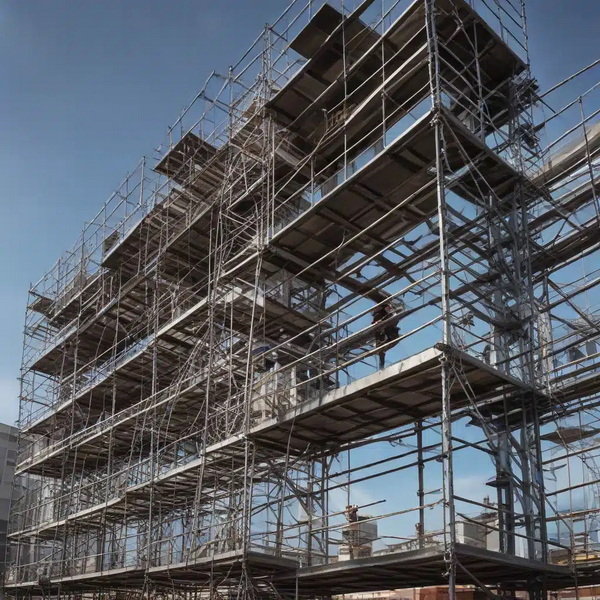
FAQ
1. What are the main components of a scaffolding frame system?
A scaffolding frame system consists of vertical frames, cross braces, base plates or adjustable jacks, platforms/planks, guardrails, toeboards, and various connectors and accessories.
2. Which projects benefit most from a scaffolding frame system?
Residential construction, commercial buildings, industrial maintenance, infrastructure projects (like bridges and tunnels), renovations, restorations, and event staging all benefit from the versatility and safety of a scaffolding frame system.
3. How does a scaffolding frame system enhance safety?
Frame systems provide stable, level platforms with integrated guardrails and toeboards, reducing the risk of falls. They are designed to meet OSHA and other safety standards, and their modular design allows for secure assembly and adjustment.
4. Can a scaffolding frame system be used indoors and outdoors?
Yes. Scaffolding frame systems are suitable for both interior and exterior projects, including building maintenance, painting, ceiling work, and exterior facade repairs.
5. What are the best practices for maintaining a scaffolding frame system?
Regularly inspect all components for damage, follow manufacturer guidelines for assembly and use, train all workers in scaffold safety, and implement fall protection measures. Keep the work area clean and monitor weather conditions for outdoor projects.













